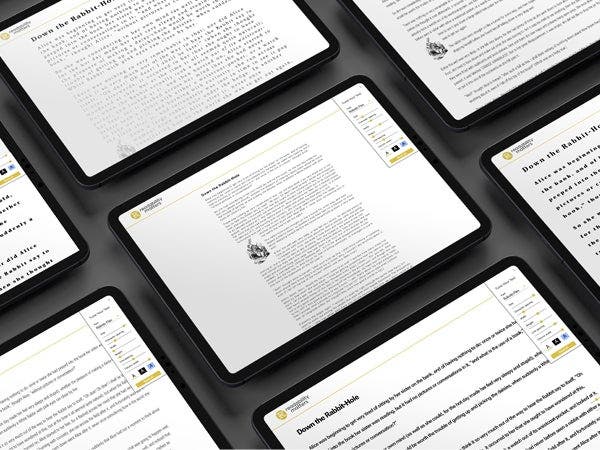User-centered approaches improve reading for all

Reading is essential to digital literacy. New technology innovations can help readers to personalize the experience and help readers of any age and skill level.
I was walking on the beach with one of my granddaughters when she asked if she could look through my eyeglasses. As she put them on I remembered trying on my parents’ glasses — and her reaction was identical to the one I remember. First, “Whoa”, as she put her hands out in front of her and swayed a bit, then, as she quickly took them off and handed them back to me, she asked, “How do you see through these things?”
Mind you, my correction is not very strong — but it is quite tailored to my eyeballs. I have a slight correction for astigmatism, some correction for near-sightedness, and a bit of a prism to correct ghosting. They are my lenses, and they are not going to work for anyone else.
Now think about reading materials — particularly reading materials we use to teach reading. One size usually tries to fit all. Sure, in the early grades we use larger fonts. And often when a child needs help with reading we find books with larger fonts or use the copy machine to enlarge the page. Consider the aging population. Libraries offer large-font books but it is generally a binary choice — normal or large font. And the literature is full of design solutions for readability — from the point of view of the designer/publisher — not the individual.
But how and what we read are changing.
E-readers like the Kindle and reading apps and endless screen time on mobile devices, phones and tablets are in widespread use. With the availability of e-reading comes the opportunity to customize our reading experience. We can choose “dark mode”, change font, and adjust character size and on occasion, line spacing.
Adobe’s Acrobat Reader now makes it easy to customize your reading experience of a PDF. Opening a PDF in Adobe Reader for mobile has a new feature called Liquid Mode that reflows the PDF to the dimensions of the device screen and provides a set of controls for adjusting font size, inter-character spacing, and inter-line spacing. And these settings are “sticky” so that once you have set them, the next PDF you open remembers that same formatting. In the near future, we may even be able to use machine learning to determine optimal formatting for each reader.
Early testing with elementary school students has shown that small changes to the formatting of text can have dramatic changes in reading proficiency — and what is quite exciting is that these improvements show up for struggling readers as well as the best readers in the class. In one of our studies, the slowest reader improved by 27 words per minute and the fastest reader improved by exactly the same score.
And this raises more questions than it answers.
If you think about it, we have been reading fixed text for 5000 years. Reading has been available to the masses since Gutenburg invented movable type 600 years ago, but customizable reading has been in the palms of our hands for perhaps 10 years. We do not have a lot of research into how we take advantage of this new capability. The first question we often hear is, “Fine. Now how do I find my personal reading format?” Or even more daunting — “I’m a reading specialist for the county schools and have 2000 students to work with — how do I provide a custom format for each of them?” Or — are there 4 reading formats that work for most of us or is it infinite? Which fonts work for which kinds of readers? Do I use the same format for all types of reading? Do I use the same format at all times of day? If you have read this far, you probably have questions of your own that come to mind.
To that end, we need research. And given the relative short time custom, electronic reading has been available, the research is thin. That is why Adobe is supporting partners like Readability Matters and the Virtual Reading Lab at the University of Central Florida to push the state of the research forward with the goal of making everyone the best reader they can be.
Check back next month to read more about some of our research efforts.
Source : Adobe








